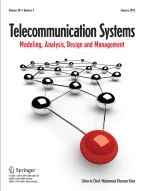Abstract
In a wireless ad hoc network, packets are sent from node-to-node in a multihop fashion until they reach the destination. In this paper we investigate the capacity of a wireless ad hoc network in supporting packet video transport. The ad hoc network consists of n homogeneous video users with each of them also serving as a relay node for other users. We investigate how the time delay affects the video throughput in such an ad hoc network and how to provide a time-delay bounded packet video delivery service over such a network. The analytical results indicate that appropriate joint admission and power control have to be employed in order to efficiently utilize the network capacity while operating under the delay constraint as the distance between source and destination changes.
Similar content being viewed by others
Explore related subjects
Discover the latest articles, news and stories from top researchers in related subjects.References
Y.S. Chan and J.W. Modestino, A joint source coding-power control approach for video transmission over CDMA networks, IEEE Journal on Selected Areas in Communications 21 (December 2003) 1516–1525.
M. Gastpar and M. Vetterli, On the capacity of wireless networks: The relay case, in: IEEE INFOCOM 2002 (June 2002).
M. Grossglauser and D. Tse, Mobility increase the capacity of ad hoc wireless networks, IEEE/ACM Transactions on Networking 10 (August 2002) 477–486.
P. Gupta and P.R. Kumar, The capacity of wireless networks, IEEE Transactions on Information Theory 46 (March 2000) 388–404.
Joint Video Team (JVT) of ISO/IEC MPEG and ITU-T VCEG, JVT-C167, H.26L, ftp://ftp.imtc-files.org/jvt-experts/.
P. Leelapornchai and T. Stockhammer, Progressive image transmission applying multipath routing in mobile ad hoc networks, in: Proc. of ICIP 2002 (September 2002) pp. 553–556.
Y. Pei, J.W. Modestino and Q. Qu, The capacity of ad hoc wireless networks supporting packet video, in: ICIP 2003 (October 2003) submitted.
T.J. Rappaport, Wireless Communications Principles and Practice (Prentice-Hall, Upper Saddle River, NJ, 1996).
A. Tsirigos and Z.J. Haas, Multipath routing in the presence of frequent topology changes, IEEE Communications Magazine 39(11) (November 2001) 132–138.
Y. Wang et al., Supporting image and video applications in a multihop radio environment using path diversity and multiple description coding, IEEE Transactions on Circuits and Systems for Video Technology 12 (September 2002).
Author information
Authors and Affiliations
Corresponding author
Rights and permissions
About this article
Cite this article
Pei, Y., Ambetkar, V.S., Modestino, J.W. et al. Enabling Real-Time H.264 Video Services over Wireless Ad Hoc Networks Using Joint Admission and Transmission Power Control. Telecommun Syst 28, 231–244 (2005). https://doi.org/10.1007/s11235-004-5018-9
Issue Date:
DOI: https://doi.org/10.1007/s11235-004-5018-9
